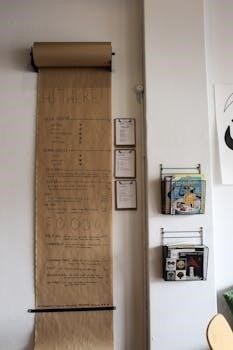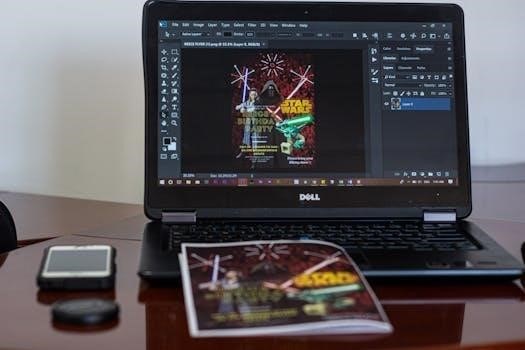summarizing graphic organizer pdf

Summarizing Graphic Organizer PDF⁚ A Comprehensive Guide
Are you looking to enhance your note-taking and comprehension skills? This guide dives into the world of summarizing graphic organizers. These visual tools aid in planning‚ organizing ideas‚ and distilling key concepts. They simplify information‚ helping you create concise summaries of any text.
What is a Summarizing Graphic Organizer?
A summarizing graphic organizer is a visual tool designed to help students and individuals condense information from a text into a concise summary. These organizers provide a structured framework for identifying key elements‚ main ideas‚ and important details‚ enabling users to distill the essence of a passage or story.
Graphic organizers come in various forms‚ each tailored to different summarizing strategies. They can include templates like the “Somebody Wanted But So Then” (SWBST) chart for fiction‚ or the “5W’s and H” organizer for both fiction and nonfiction. These templates offer prompts and sections to guide users through the summarization process.
By visually structuring the information‚ graphic organizers help overcome challenges in condensing a story or breaking down long texts. They support learners in identifying characters‚ conflicts‚ rising action‚ climax‚ and resolution in fiction‚ or main ideas and supporting details in nonfiction. This structured approach enhances reading comprehension and promotes effective summarization skills.
Benefits of Using Graphic Organizers for Summarizing
Graphic organizers offer a multitude of benefits for summarizing information‚ enhancing comprehension‚ and improving writing skills. They provide a clear structure for planning and organizing ideas‚ making the summarization process more manageable. By visually representing key elements‚ graphic organizers help students identify and connect important details‚ fostering a deeper understanding of the text.
These tools are particularly helpful for students who struggle with executive functioning challenges‚ dysgraphia‚ or working memory issues. They break down complex information into smaller‚ more digestible parts‚ reducing cognitive overload. Graphic organizers also encourage concise writing‚ prompting students to distill key concepts and important details effectively.
Furthermore‚ using graphic organizers promotes active reading and critical thinking. Students actively engage with the text‚ analyze its components‚ and synthesize information to create a meaningful summary. This active engagement fosters better retention and improves overall reading comprehension. Ultimately‚ graphic organizers empower students to become more confident and effective summarizers.
Types of Summarizing Graphic Organizers

Several types of graphic organizers can assist in summarizing various texts‚ each with its unique approach and structure. One popular type is the “Somebody Wanted But So Then” (SWBST) organizer‚ which is particularly effective for fiction. It prompts students to identify the main character (Somebody)‚ their goal (Wanted)‚ the conflict they faced (But)‚ the actions they took (So)‚ and the resolution (Then).
Another useful organizer is the “Five Sentence Summary‚” suitable for both fiction and nonfiction. This template guides students to state the main idea‚ provide three key details‚ and conclude with a wrap-up or resolution. The 5W’s and H organizer focuses on who‚ what‚ when‚ where‚ why‚ and how‚ ensuring a comprehensive summary.
Other types include sequence of events charts‚ which are ideal for summarizing chronological texts‚ and main idea and details organizers‚ which help students identify the central theme and supporting information. The choice of organizer depends on the text type and the specific summarizing goals.
Somebody Wanted But So Then (SWBST) Organizer
The Somebody Wanted But So Then (SWBST) organizer is a powerful tool specifically designed to help students summarize fictional stories. This graphic organizer prompts students to identify and record the key elements of a narrative in a structured format‚ leading to a concise and comprehensive summary. The framework helps students understand the story’s central components.
“Somebody” refers to the main character or characters in the story. “Wanted” focuses on what the character hopes to achieve or their primary goal. “But” identifies the problem or conflict that prevents the character from reaching their goal. “So” describes the actions the character takes to overcome the conflict. “Then” explains the outcome or resolution of the story.
By filling out each section of the SWBST organizer‚ students can easily condense the story’s plot into its essential elements. This method promotes a deeper understanding of the narrative structure and strengthens summarizing skills. The SWBST is a simple yet effective way to teach story comprehension.
Five Sentence Summary Organizer

The Five Sentence Summary organizer is a versatile tool applicable to both fiction and nonfiction texts‚ designed to help students distill information into its most crucial points. This framework encourages concise summarization by guiding students to craft a brief yet comprehensive overview in just five sentences. The template breaks down the summarizing process into manageable steps.
The first sentence typically focuses on the main topic or central idea of the text. The next three sentences are dedicated to outlining significant details or facts that support the main idea. These supporting sentences provide depth and context to the summary. The final sentence serves as a conclusion‚ wrapping up the summary with a resolution or final thought.
By adhering to the five-sentence structure‚ students are challenged to be selective with their words and prioritize the most essential information. This exercise not only improves summarizing skills but also enhances the ability to identify and articulate key concepts. This method is both structured and flexible.
5W’s and H Organizer
The 5W’s and H organizer is a classic and effective method for summarizing information‚ particularly useful for both fiction and nonfiction texts. This approach prompts students to consider the Who‚ What‚ When‚ Where‚ Why‚ and How of a story or informational piece‚ ensuring a comprehensive understanding and summary. By addressing each of these key elements‚ students can create a well-rounded and informative overview of the material.

“Who” focuses on the characters or individuals involved in the text. “What” identifies the main events or actions that take place. “When” establishes the time frame in which the story or events occur. “Where” sets the scene or location of the text. “Why” explores the reasons or motivations behind the events or actions. Finally‚ “How” describes the manner in which the events unfold or the actions are carried out.
This organizer is especially beneficial for students who struggle with executive functioning challenges‚ as it provides a clear and structured framework for gathering and organizing information. By answering each of the 5W’s and H‚ students can effectively plan and construct a coherent and complete summary.
Graphic Organizers for Fiction vs. Non-Fiction
When summarizing‚ the type of text significantly influences the choice of graphic organizer. Fiction‚ with its emphasis on characters‚ plot‚ and setting‚ benefits from organizers like the SWBST (Somebody Wanted But So Then) chart‚ which helps students capture the story’s essential elements‚ including the conflict and resolution. Character maps are also useful for tracking character development and relationships‚ providing a deeper understanding of the narrative.
Non-fiction‚ on the other hand‚ requires a different approach. Organizers like the 5W’s and H (Who‚ What‚ When‚ Where‚ Why‚ How) are ideal for extracting key information and facts from informational texts. The main idea and details organizer is also effective‚ as it prompts students to identify the central theme and supporting evidence. Sequence charts can be used to illustrate chronological events or processes‚ ensuring accurate comprehension of the text’s structure.
By selecting the appropriate graphic organizer‚ students can effectively tailor their summarizing strategies to the specific demands of fiction and non-fiction texts‚ leading to improved comprehension and retention.
Free Printable Summarizing Graphic Organizer Templates
Finding the right graphic organizer can be a game-changer for students struggling with summarizing. Fortunately‚ numerous free printable templates are readily available to educators and parents. These templates offer a structured framework for students to condense information effectively‚ whether they’re working with fiction or non-fiction texts. From simple charts to more elaborate diagrams‚ these resources cater to diverse learning styles and grade levels.
For fiction texts‚ consider templates like the “Somebody Wanted But So Then” (SWBST) organizer‚ which prompts students to identify key story elements. Alternatively‚ a character map can help visualize relationships and motivations. For non-fiction‚ the 5W’s and H organizer is invaluable for extracting essential facts‚ while a main idea and details chart aids in identifying the central theme and supporting evidence.
Many websites offer a variety of these templates for free download. Simply search for “free printable summarizing graphic organizers” to access a wealth of resources. Select the templates that best suit your students’ needs and watch their summarizing skills improve. Remember to choose templates that are clear‚ concise‚ and age-appropriate to maximize their effectiveness.
Using Graphic Organizers to Improve Reading Comprehension
Graphic organizers are powerful tools for boosting reading comprehension. They provide a visual framework that helps students actively engage with the text‚ organize their thoughts‚ and identify key information. By using these organizers‚ students move beyond simply reading words to truly understanding and retaining what they’ve read.
When students use graphic organizers‚ they must actively process the text to fill in the relevant information. This active engagement forces them to identify main ideas‚ supporting details‚ characters‚ plot points‚ and other essential elements. The act of organizing this information visually reinforces their understanding and makes it easier to recall later.
Moreover‚ graphic organizers can help students make connections between different parts of the text and between the text and their own prior knowledge. This deeper level of processing leads to improved comprehension and critical thinking skills. By providing a structured approach to reading‚ graphic organizers empower students to become more confident and effective readers. Ultimately‚ using graphic organizers is not just about summarizing; it’s about fostering a deeper‚ more meaningful understanding of the text.
Adapting Graphic Organizers for Different Grade Levels
Graphic organizers aren’t a one-size-fits-all solution. Successfully implementing them requires adapting the complexity and format to suit the specific grade level and developmental stage of the students. For younger learners‚ simpler organizers with fewer sections and more visual cues are ideal. Think of using pictures or icons alongside words to represent characters‚ settings‚ or events.

As students progress to higher grade levels‚ the graphic organizers can become more sophisticated. Middle schoolers might benefit from organizers that require them to analyze cause-and-effect relationships or compare and contrast different perspectives. High school students can use complex organizers to synthesize information from multiple sources and develop their own arguments.
Consider scaffolding the process by gradually increasing the level of independence required. Start with guided practice‚ where you model how to complete the organizer‚ and then gradually release responsibility to the students. Provide sentence stems or word banks to support students who are struggling. Remember‚ the goal is to empower students to become active readers and effective summarizers‚ so adapt the tools to meet their individual needs and learning styles.
Digital Graphic Organizers for Summarizing
In today’s digitally driven world‚ digital graphic organizers offer a dynamic and engaging alternative to traditional paper-based methods. These interactive tools provide students with a collaborative and accessible way to summarize information and enhance comprehension. Digital platforms offer various templates that can be easily customized to suit different learning styles and content areas.
One key advantage of digital graphic organizers is their ability to facilitate collaboration. Students can work together in real-time‚ brainstorming ideas‚ sharing insights‚ and co-creating summaries. This collaborative aspect fosters communication skills and promotes a deeper understanding of the material.
Furthermore‚ digital organizers offer features like drag-and-drop functionality‚ image integration‚ and multimedia embedding‚ making the summarizing process more interactive and engaging. These features allow students to express their understanding in diverse ways‚ catering to different learning preferences. Popular platforms like Google Classroom offer seamless integration with digital graphic organizer tools‚ making them readily accessible to students and teachers alike.